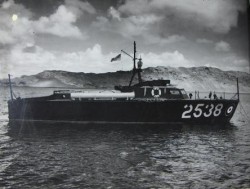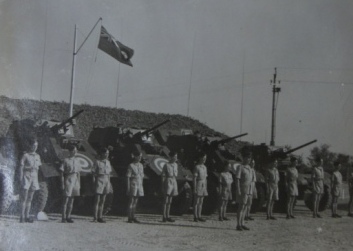From Banana to Vesuvius…
When one thinks of the RAF in the Second World War, most people have visions of squadrons of Spitfires and Hurricanes over Kent in 1940, or the Dambusters of 617 squadron. The Operational Record Books (‘ORBs’ or more formally RAF Forms 540 and 541) of the squadrons have always been very popular records and are now online. But nearly every unit of the RAF had to compile and submit ORBs, and the majority of these units were not squadrons at all, but an amazing variety of other units, and their ORBs have been gathered together in record series AIR 29 as ‘Miscellaneous Units’.
For the last two years, a small team of staff have been working through the AIR 29s up to the end of the Second World War, improving and expanding the catalogue descriptions, to make the records easier to locate. Many of the original descriptions were very brief, and relied heavily on unexplained abbreviations, which didn’t make searching very easy (anyone want to guess at what ‘AACU’ or ‘Beam ATF’ stood for?).
In going through the first 1,212 pieces of the series, we have found units completely missed from the catalogue, unravelled all of the abbreviations, corrected dates and detailed the changes of unit name or location. A typical description before the project was ‘AIR 29/811: No. 428, Buc’. This has now been expanded to ‘428 Repair and Salvage Unit, based at Buc, France (RSU)’. Unit abbreviations were retained as they often appear on airmen’s service records from this period. Place-name descriptions were also improved so that researchers can use the records even if they do not know which units were in which locations.
The records are now searchable using the following terms:
- Full unit designations
- Common unit abbreviations
- Representative UK place names (all marked as UK)
- Common foreign countries, regions and places
- Other material such as photographs or magazine
In doing this work, we have uncovered the wide variety of supporting units, on the ground, in the air, and even at sea, that sat behind (and sometimes in front) of the squadrons.

More than just planes – HSL 2538 (catalogue ref: AIR 29/449)
Besides the standard Forms 540 and 541, there are many photographs, plans, technical drawings, Christmas menus and unit magazines or newsletters. Wherever possible we have noted the existence of these in the improved descriptions. Some of the units themselves have cryptic names, such as the large number of ‘AMES’ or ‘Air Ministry Experimental Station’, which was the cover name for both static and mobile radar units for much of the war. There is a large collection of intelligence reports including the aerial photographs from the Central Interpretation Unit at Medmenham (AIR 29/230-412) – a little known unit which was rated as important and was kept as secret as Bletchley Park. [ref] 1. Spies in the Sky – www.taylordowning.com/spies-in-the-sky[/ref]
For those searching for individuals, many of the records include details regarding postings, promotions, awards, injuries, and courts-martial, but there are no name indexes, and some records have little or no mention of individuals at all. Accidents are often mentioned, both aircraft and motor accidents. It is often worth searching by location of the accident or crash, as often the nearest unit would be called to assist, even if it was not responsible for the aircraft or vehicle concerned.
These units served in every corner of the globe, from the RAF Delegation in Washington DC (AIR 29/929) to the Staging Post in Townsville, Australia (AIR 29/476) and in every theatre of war. To explain the sub-title of this post, which demonstrates the variety, the series includes the records of a seaplane refuelling unit stationed at the remote outpost of Banana on the coast of the then Belgian Congo (AIR 29/32), and elsewhere, the record of 3 Base Area includes a detailed description of the devastating eruption of Vesuvius in March 1944 (AIR 29/840).
The work isn’t finished however. Having improved the descriptions at piece and item level, the higher level descriptions have been found lacking, and will be tackled next.
In case you were wondering, ‘AACU’ is short for Anti-Aircraft Co-Operation Unit, who provided aerial targets for anti-aircraft artillery units, and ‘Beam ATF’ is short for Beam Approach Training Flight, (commonly known as BAT Flights) which were established to train pilots in using the new aids which allowed them to land in poor visibility .

A very useful and welcome project. In the longterm are you planning to digitise these ORBs as has happened with the Squadron Record Books (AIR 27)?
Simon, thanks for the positive feedback. It would be nice to see them online to complement AIR 27, but there are no current plans to do so. The AIR 27’s were easier to put online because we already had microfilm copies of the records.
Great project – I have noted this down for future reference (and to forward on to my family history group) and I look forward to taking a look at these records when I next visit Kew.
Hi Lee,
My late father enlisted as a boy apprentice soon after the end of WW1 and served through WW2.
He was an avid photographer and his collection of RAF relate photos were reportedly turn over to the RAF by mother.
His name was Francis George Gentry, and I would be interested if any of this material made it to the National Archives.
FWIW, I still have not obtained a copy of his service record.
However I do have a few of his masonic papers and some notes on reunions.
Many of his masonic brothers will also have served with him.
Hope to hear back from you.
Regards
Jonathan Gentry in Toronto, Canada
Hi Jonathan,
There are plenty of photographs in these records, including visits by VIP’s, group photographs of personnel, and photogrpahs of the activities of the units. I have also found some photographs of damage caused by bombing. The ones I have seen are official photographs, rather than taken privately by airmen. It is possible his photographs have ended up somewhere else, rather than part of the official record. It may be worth contacting the RAF Museum at Hendon to see if they have them http://www.rafmuseum.org.uk/research/default/photographs.aspx.
Your father’s service record will still be held by the Minsitry of Defence. To find out how to apply for a copy, visit http://www.veterans-uk.info/service_records/service_records.html
Good luck with your research.
Lee
My dad was in salvage and recovery in WW11 in the RAF. I can’t really find out any information on this role. I know he was in Antwerp in 1945 and was deeply affected but I don’t know why or what. Can you help. I would like to find his records too but have struck a blank so far.
Sue
Hi Sue,
there was a lot of salvage and recovery activity of various kinds both at home and abroad. You really need to get his service record first, which should tell you which units he was in, then you would be able to look at the Operational Record Books for those units, which should fill in some gaps.
Your father’s service record will still be held by the Minsitry of Defence. To find out how to apply for a copy, visit http://www.veterans-uk.info/service_records/service_records.html
Good luck with your research.
Lee
My grandfather served with 428 RSU at Buc – he was very pleased to see a mention!
Hi my name is Ronald Bommel. I’m a hearing impaired and I have a Learning Disability. My father is Julius Bommel. He was in the POW in Iwo Jime.. I don’t know what rank and where he went into the service. He was an the Royal Dutch Air Force and then Navy. Can anyone tell or explain about it? I’m just curious and wanted to know. He also was one of the survivors escaped from the Burma Road infamy in Burma. My email is rbommel52@gmail.com
Thank you.
Ronald
Thank you for contacting The National Archives’ Blog. We aren’t able to help with records research but you can send an enquiry to The National Archives using the contact form at http://apps.nationalarchives.gov.uk/Contact/contactform.asp?id=1
Weather reports can be of use especiaaly as they were not published during the war.
My father’s Julius Bommel. He was in the Dutch RAF. He was a POW in Burma somewhere in the 1940s. I would like to know more about what he did in the war and in the POW. Thanks!
My father was in 101 MARU Mobile Air Reporting Unit and was involved in the invasion of Sicily in July 1943 and then later into mainland Italy. What is the significance of 101? It does not seem to be connected to a Flight or Squadron.
Hi Andrew,
Thank you for your comment.
We’re unable to help with research requests on the blog, but if you go to our contact us page: http://nationalarchives.gov.uk/contact/ you’ll see how to get in touch with our record experts via phone, email or live chat.
I hope that helps.
Nell